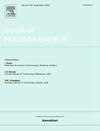评价六氰高铁酸铝对PGM的利用和对模拟高水平后萃物中Mo的去除,以减少储存库面积
IF 2.3
3区 工程技术
Q1 NUCLEAR SCIENCE & TECHNOLOGY
引用次数: 0
摘要
高燃耗的轻水堆和MOX乏燃料含有更高水平的铂族金属(PGMs);Pd, Ru, Rh)和Mo,需要对它们进行控制,以确保玻璃熔炼机稳定运行并防止黄相形成,从而保持玻璃的质量。在后处理过程中分离pgm和Mo可以显著减少玻璃化高放废物(HLWs)所需的存储空间。本研究探索了使用六氰高铁酸铝(AlHCF)同时分离PGMs和Mo,其中涉及在吸附过程中结构Al的洗脱。开发了一种基本的方法来分析核燃料循环(NFC)的后端过程,重点是AlHCF的定量影响。通过将模拟高放废液(sHLLW)的吸附实验与NMB 4.0的质量平衡计算和导热计算相结合,确定了AlHCF的实际利用条件(11% ~ 40%的废物负荷和100 ~ 200 kg/tHM的AlHCF)。它还建立了AlHCF数量、废物装载、玻璃化废物减少和存储库大小之间的关系,突出了最小化存储库占用空间的最佳条件。本文章由计算机程序翻译,如有差异,请以英文原文为准。
Evaluation of Aluminum Hexacyanoferrate utilization for PGM and Mo removal from simulated high-level-raffinates in reprocessing for repository area minimization
Higher burnup LWR and MOX spent fuels contain increased levels of Platinum Group Metals (PGMs; Pd, Ru, Rh) and Mo, necessitating their control to ensure stable glass melter operations and prevent yellow phase formation, thereby maintaining vitrified glass quality. Separating PGMs and Mo during reprocessing can significantly reduce the repository space required for vitrified high-level wastes (HLWs). This study explores the use of Aluminum Hexacyanoferrate (AlHCF) for simultaneous separation of PGMs and Mo, which involves the elution of structural Al during sorption. A fundamental methodology was developed for analyzing the back-end processes of the nuclear fuel cycle (NFC), focusing on the quantitative impact of AlHCF. By integrating adsorption experiments of simulated high-level liquid waste (sHLLW) with mass balance calculations and thermal conductive calculation via NMB 4.0, the study identified practical AlHCF utilization conditions (11 to 40 wt% waste loading and 100 to 200 kg/tHM of AlHCF). It also established the relationship between AlHCF amount, waste loading, and reductions in both vitrified waste and repository size, highlighting optimal conditions for minimizing repository footprint.
求助全文
通过发布文献求助,成功后即可免费获取论文全文。
去求助
来源期刊

Annals of Nuclear Energy
工程技术-核科学技术
CiteScore
4.30
自引率
21.10%
发文量
632
审稿时长
7.3 months
期刊介绍:
Annals of Nuclear Energy provides an international medium for the communication of original research, ideas and developments in all areas of the field of nuclear energy science and technology. Its scope embraces nuclear fuel reserves, fuel cycles and cost, materials, processing, system and component technology (fission only), design and optimization, direct conversion of nuclear energy sources, environmental control, reactor physics, heat transfer and fluid dynamics, structural analysis, fuel management, future developments, nuclear fuel and safety, nuclear aerosol, neutron physics, computer technology (both software and hardware), risk assessment, radioactive waste disposal and reactor thermal hydraulics. Papers submitted to Annals need to demonstrate a clear link to nuclear power generation/nuclear engineering. Papers which deal with pure nuclear physics, pure health physics, imaging, or attenuation and shielding properties of concretes and various geological materials are not within the scope of the journal. Also, papers that deal with policy or economics are not within the scope of the journal.
 求助内容:
求助内容: 应助结果提醒方式:
应助结果提醒方式:


